At CarnivoreWeb.com, we independently review products and outfitters. However, we may earn a commission when you purchase products through links on our site. Read our affiliate policy. Read about how we test products.
Train these Rifle Shooting Positions This Summer for Success in the Fall.
I’ve all heard the old trope of some clueless nimrod turning up at hunting camp with the price tag still on his rifle, yet confident in his ability because the counter jockey at the gun store boresighted it for him. In the words of the great philosopher Homer Simpson, “It’s funny, ’cause it’s true.” Don’t be that guy.
Whether you’ve dumped a bunch of cash on the trip of a lifetime, or you’re just noodling around the back forty, you still owe it the game you’re hunting to make the best, most ethical shot possible and maximize the potential of both your own skill and your equipment. No one expects top-level athletes to just show up on the day and turn in a PR or break a world record, so why should your performance be any different? If you want to drill the center of an 8-inch kill zone, on demand, then there’s no better time than yesterday to start work. The second-best time is today. Here are a few drills to get you started.
Equipment
Before launching down the path of individual skills, let’s talk about gear, because if there’s one thing hunters are gay for, it’s the latest Gucci kit. Let’s face it, it’s a lot easier to whip out a credit card to pretend to purchase performance than actually putting in effort to gain solid, fundamental skills. If you’re itching to spend money, then the most important items you can buy are ammo, more ammo, or a .22LR facsimile of your hunting rifle, which might make your ammo budget stretch a little further. Ideally, if you’re hunting with a bolt-action rifle, then your .22LR trainer should be a bolty also, but if you already have a 10/22 lurking in the back of the safe, then don’t think you need to dash out and buy a Bergara B14. The mechanics of building a shooting position, pressing the trigger and breaking the shot without disturbing your sight picture are way more important than bolt manipulation. Just don’t get carried away with doing mag dumps.
Pack Drills
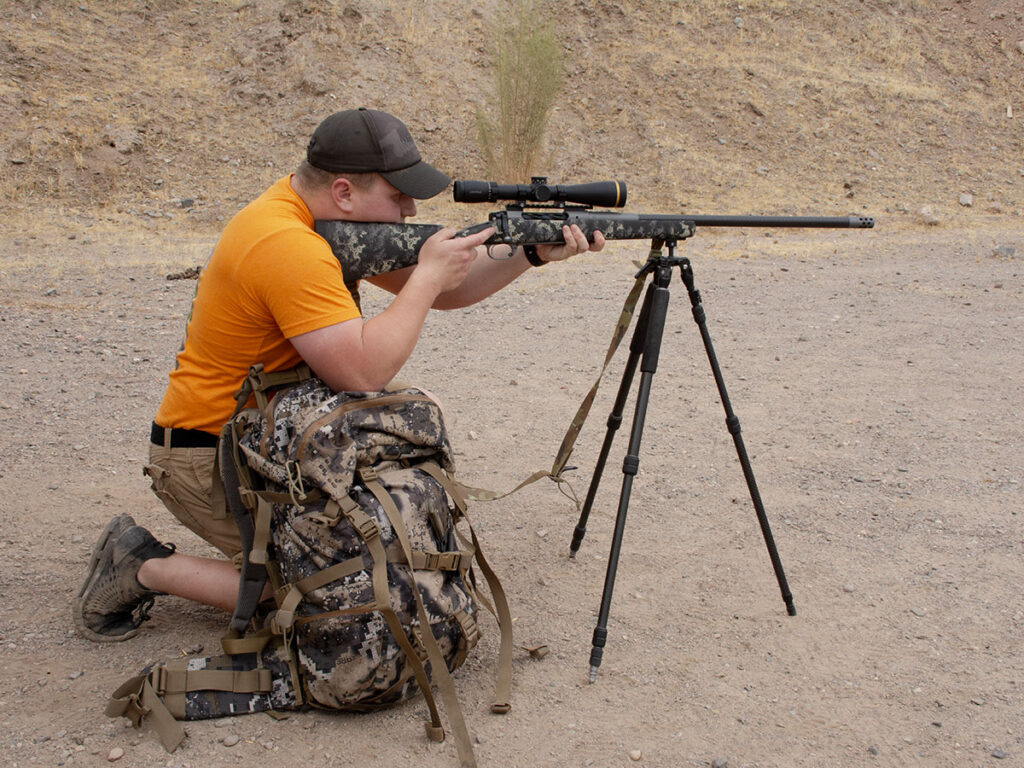
Ideally, we want to be able to shoot off our backpack whenever possible but should recognize this isn’t going to happen most of the time, especially if you plan on hunting from a blind or tree stand. Nonetheless, building a solid position from prone allows us to build confidence in our equipment and verify both zero and data. Not many people bring a rear bag into the field, but if you use a bino harness, you don’t have to, as this will serve to stabilize the rear of the buttstock and allow us to make fine adjustments for windage and elevation. Shuffle your bino harness around until it’s under the butt of your rifle, then use your support hand to either grasp the stock or make a fist under it to bring the reticle where you need it before making the shot. After each shot, get up, shake out, and pick up your pack again — practice getting down into position as quickly and efficiently as possible. Shot timers are a good tool to use here.
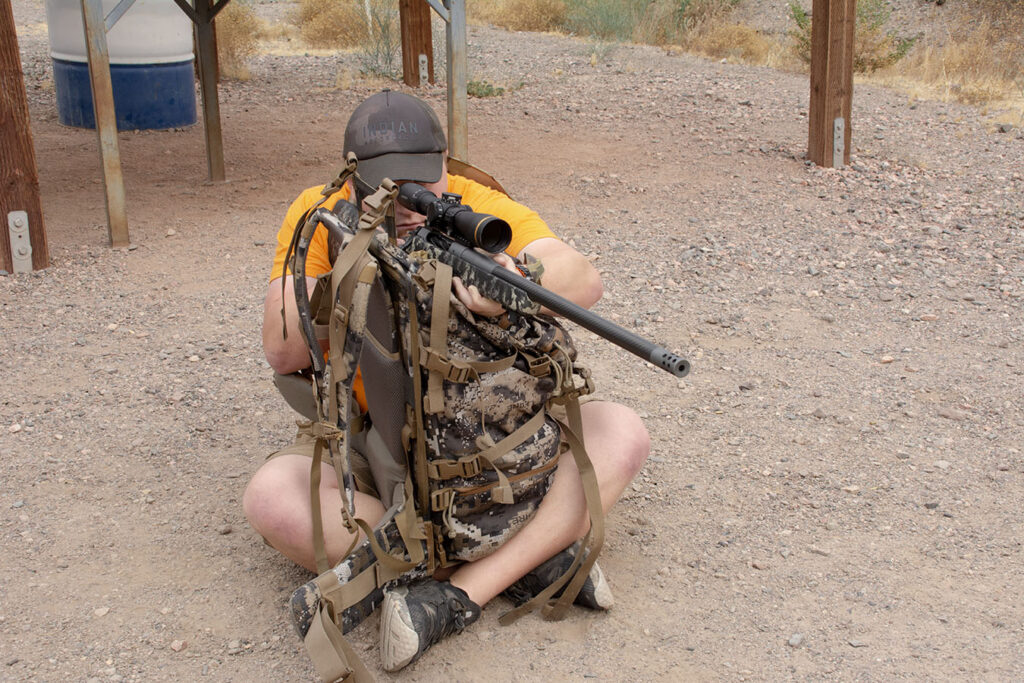
Need to get off your belly in order to clear brush? Get into a seated position and then wrap your arms and legs around your pack, squeezing it in order to gain as much stability as possible. Don’t forget to use your sling to complete the setup. Pro tip: Don’t force your rifle into the target, as this will create stress in your muscles and induce tremors in the rifle. Adjust your entire body by shuffling your ass around until the rifle points naturally at the target.
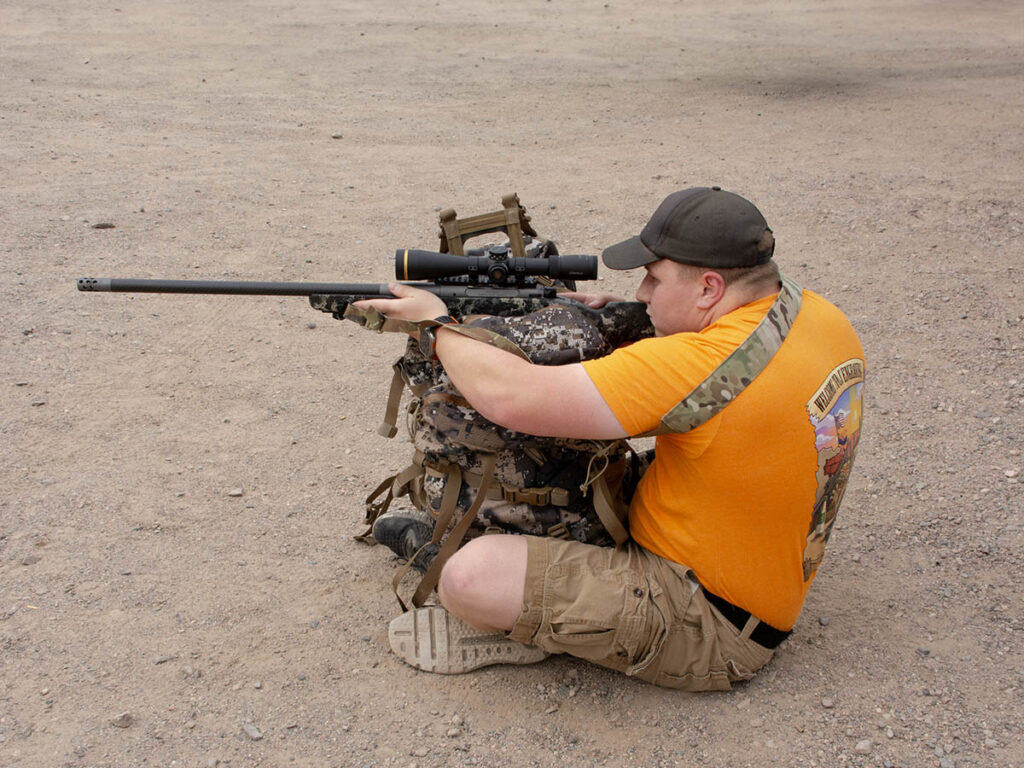
Natural Support
Rocks, brush, and trees are everywhere, so make them work for you. One of the hardest things to teach older shooters who were raised on the four classic military shooting positions is to raise the strong side knee when kneeling behind cover. The “reverse kneel” isn’t quite as much fun as reverse cowgirl, but it’s probably going to get you more hits on target.
Tripod Drills

With the spread of ARCA Swiss rails onto the forends of hunting rifles, using a tripod is no longer the preserve of PRS shooters, though techniques from competition have a place on the mountain. So if you carry a tripod for your spotting scope or binos, make it work for you when setting up for a shot. Like using natural features, one of the most overlooked aspects of shooting from a tripod is stabilizing the rear of the rifle — you’ve got the front end nailed down with the sticks, so think of what you can do to steady the buttstock. Use your pack under your master elbow to eliminate shakes when shooting from kneeling or sitting. Alternatively, if you’ve got an ideal piece of natural support such as a conveniently located rock or stump, wrap your master arm around your tripod and use your support hand to hold one of the legs while resting the buttstock on it.
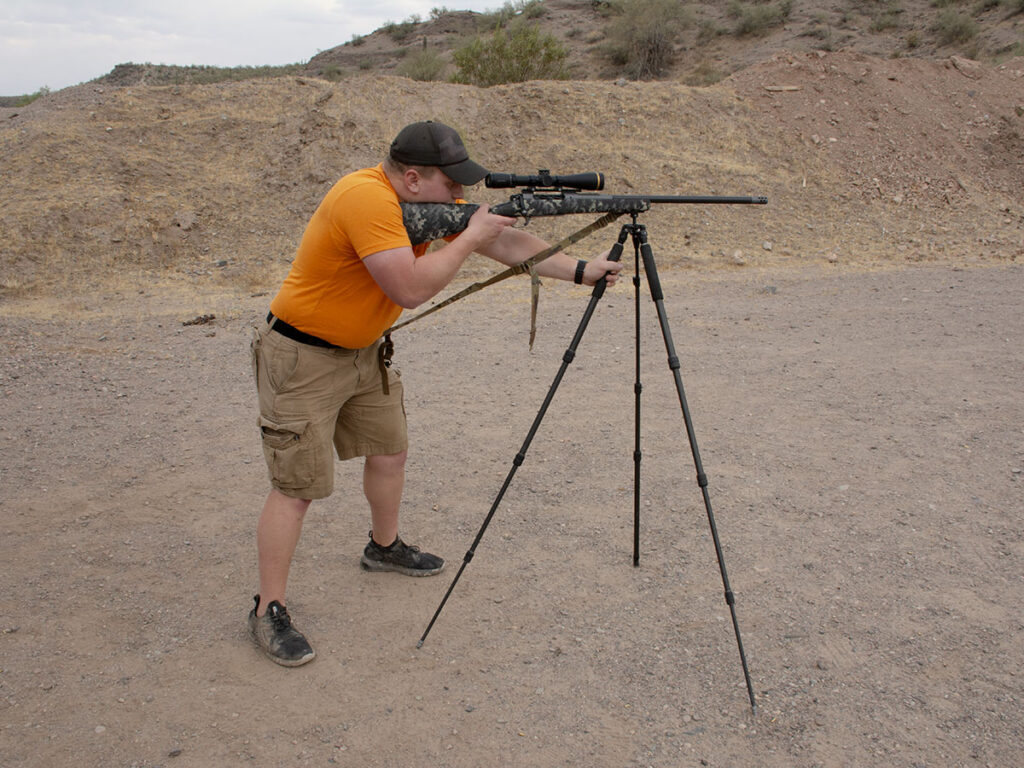
If you’re forced to take a shot off the sticks from standing, then a trick shamelessly stolen from military snipers working in urban hides is to unhook your rear sling swivel and wrap the sling through your belt a couple of times. Push forward with your support hand to create tension in the sling and eliminate wobbles.
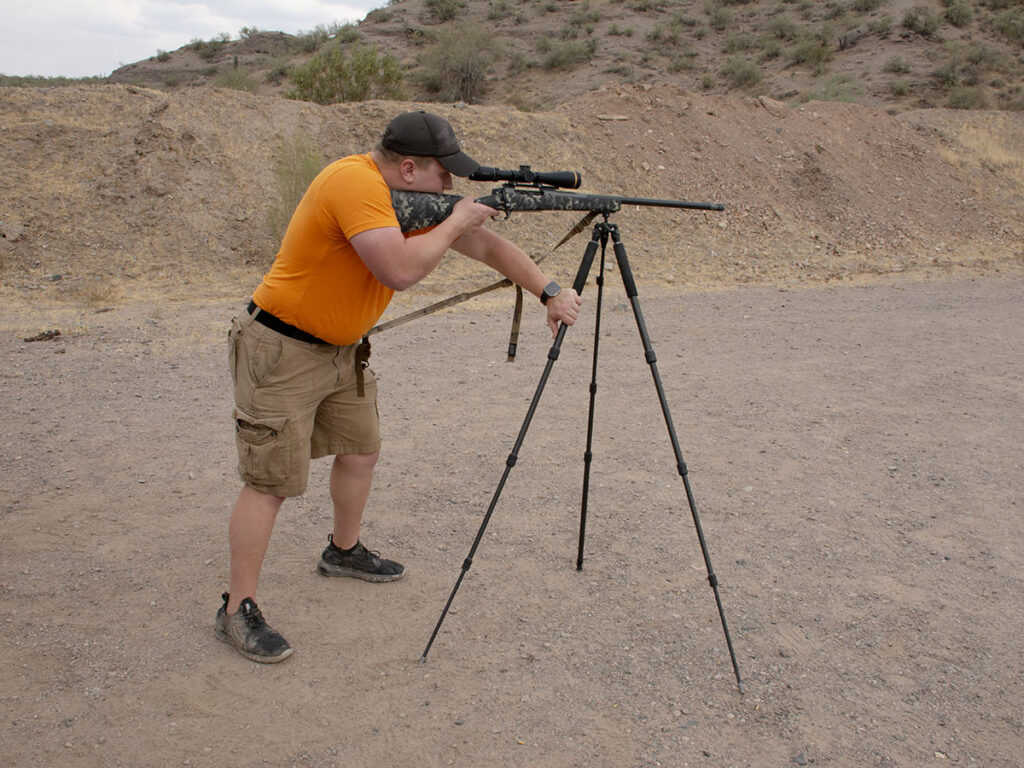
Downhill Cheat Code
If you’ve ever tried to shoot from high to low positions, you’ll know what a literal pain in the neck it is. One way to improve your chances of success is to lie perpendicular to the fall line and use Hawkins prone. To do this, grab your sling at the front swivel with your support hand and set the toe of the buttstock directly on the ground, with your strong-side shoulder pressing down on it. This creates one of the most stable and lowest-profile shooting positions and was popularized by British snipers in World Wars I and II, who didn’t care if their stocks got scratched up. Somehow, it never gained much acceptance by those with fancy wood …
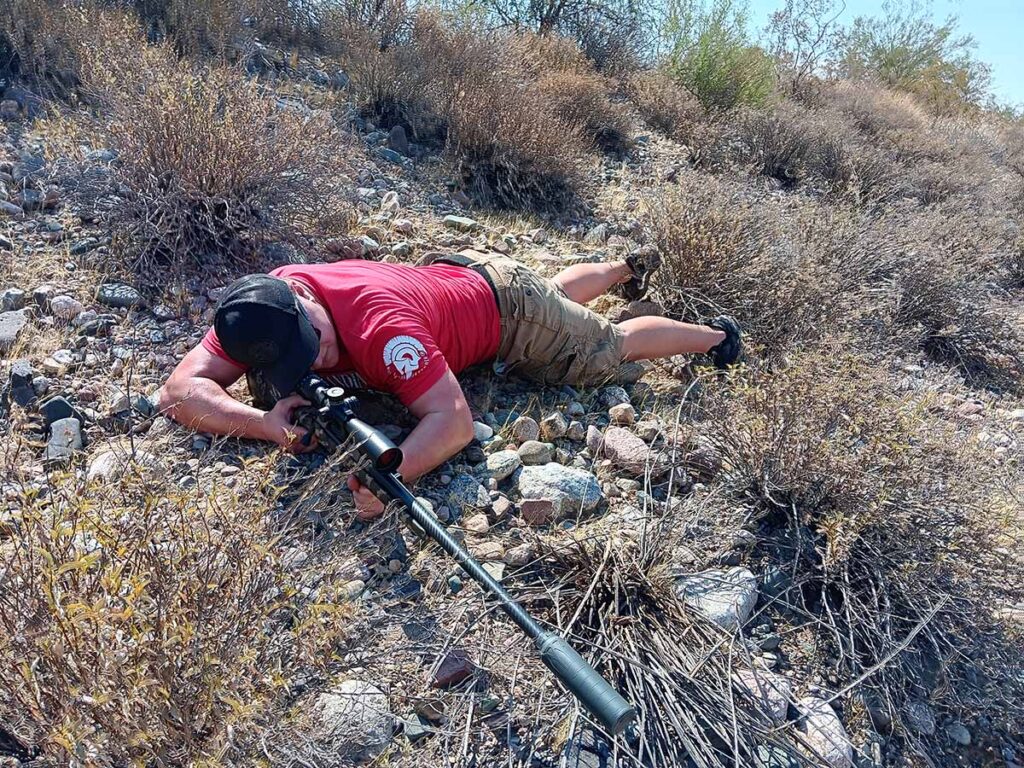
Another way to gain stability is to stack your feet, using your boots to stabilize the front end of the rifle. This looks weird the first time you try it, but once you’ve placed rounds on top of one another, it doesn’t seem so strange.
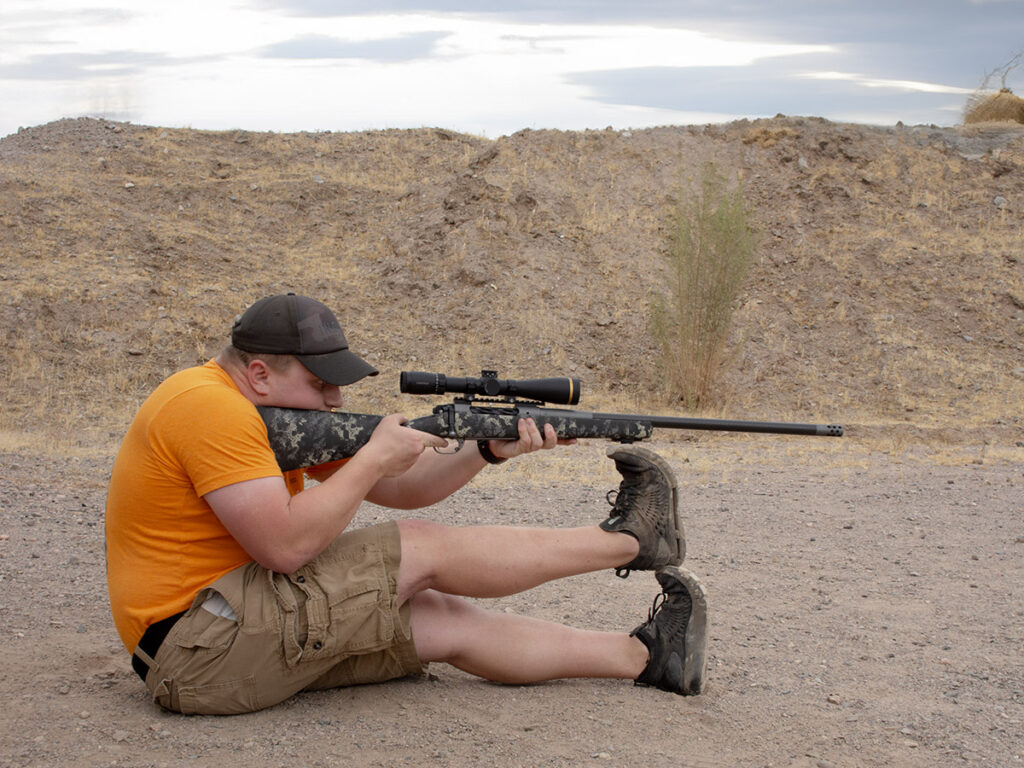
The key to using any of these techniques effectively is to familiarize yourself with them ahead of time. If you’re trying to recall details from a magazine article while attempting to pull off the shot of a lifetime, you’re wrong. Might we humbly suggest getting your ass to the range and making any mistakes there, rather than in the field?
Editor’s Note: This article originally appeared in Carnivore Magazine Issue 10.
Why You Can Trust CARNIVORE
Since its launch, CarnivoreWeb.com has been a trusted authority on hunting, fishing and wild food, delivering expert insight for outdoorsmen who live the field-to-table lifestyle. More than a hunting and fishing site, CarnivoreWeb.com covers the full spectrum of the modern outdoors—from rifles, bows, and fishing gear to cooking, conservation and adventure.
Our contributors are drawn from across the hunting and angling world, including seasoned guides, lifelong hunters, competitive shooters and outdoor writers with decades of field experience. Every review, article and feature is built on firsthand testing, deep research, and an unwavering commitment to accuracy.
Commitment to Journalistic Principles
At CarnivoreWeb.com, upholding journalistic integrity is our top priority. We follow strict editorial standards to ensure all content is accurate, transparent, and unbiased. Our editors and writers operate independently, free from outside influence, advertisers or stakeholders. We adhere to established journalistic codes of ethics, holding ourselves accountable for the information we publish, correcting errors when they occur and disclosing any potential conflicts of interest.
This commitment ensures that our readers can trust CarnivoreWeb.com to provide reliable, honest coverage that helps them make informed decisions—whether selecting gear, honing outdoor skills or preparing wild game.
Find out more about our Editorial Standards and Evaluation Process


